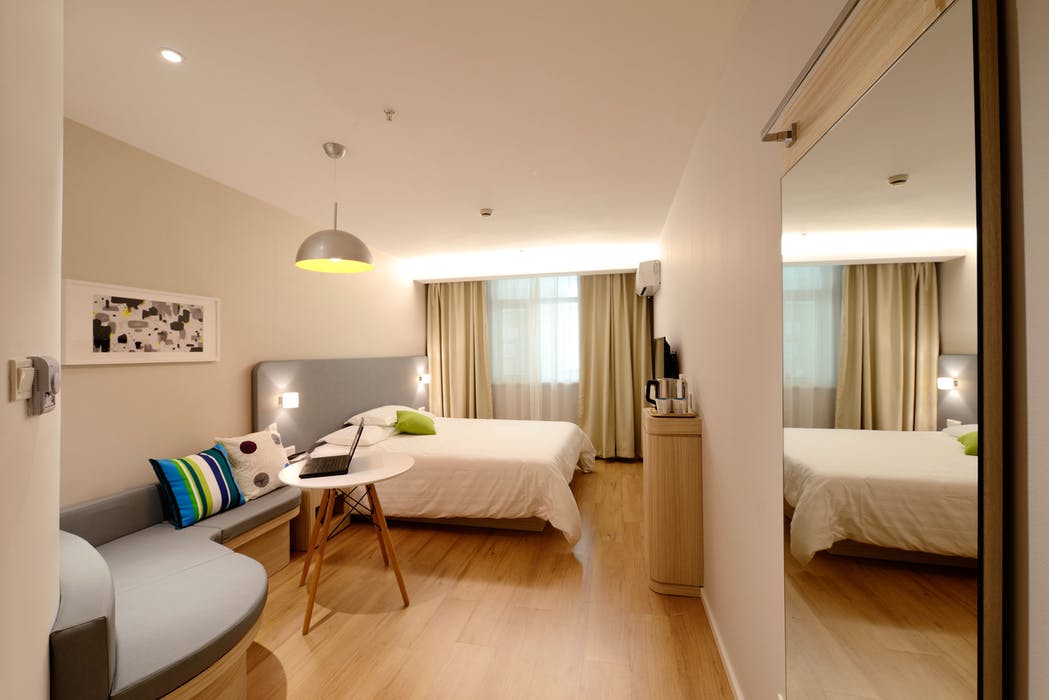Closing Steps for CNA/Caregiver Skills
This page describes the closing steps for performing certified nursing assistant (CNA) or caregiver skills. These should be the last steps taken after completing any skill. Even though I will be focusing primarily on all of the points you should cover in order to pass the clinical skills portion of the CNA exam, these tips can be used in real world settings as well. Click here for the opening steps.
Comfort Head Bed Bed Alarm Call Light Environment Curtain Lights Door Handwashing Document

Ask about Comfort
Keeping your patient comfortable should be right up there with keeping them safe. Even if they are safe, if they aren't happy and comfortable, then they are having a negative experience. It is your job to make sure they are having the best experience possible. Whatever you can do for them at that moment to make them feel better should be done.
Asking about comfort can include things such as adjusting the thermostat in the room or adjusting their blanket, to getting something for them to eat or drink, as long as their diet permits it of course. Asking them first before you leave prevents you from having to go back moments later to do something you could have done while you were still in their room.
Adjust the Head of the Bed
Adjusting the head of their bed seems minor, but can make a big difference. If your patient can't do it for themselves, it should be done before you leave. Even if they are capable, make sure they know how to. Not only does this affect their comfort level, it can also let them know when it is time to go to sleep or time to wake up or eat.
Another important factor to consider is the way it affects their health. Depending on their condition, it could be harmful to leave their bed in a specific position. Examples include raising the head up to ease breathing with patients with COPD, or keeping the head of the bed lowered after repositioning them onto their side to prevent strain on their spine.
Keep the Entire Bed Height in the Lowest Position
This step can't be overstated. Raising the bed higher to reduce strain on your back is encouraged as long as it is lowered back down, which can easily be missed if you are in a hurry. If the patient is lying in bed and tries to get out, the bed height can often be the cause of a fall and potential injury. You can't assume they will realize the bed is higher than it was when they first got into it.
Just think if you woke up one morning after a good night's rest and attempted to hop out of bed like you normally do, only to realize the floor is two feet lower than it normally is. This is what your patient would experience too. You can't blame them by saying they simply aren't paying attention. Your brain and body goes through routines and when something changes unexpectedly, injury can occur.
Turn on the Bed Alarm if Necessary
This is another factor that helps prevent falls which are all too common in healthcare. If the patient is a fall risk, which means they are not steady on their feet by themselves, it is often a good idea to go ahead and put a bed alarm or chair alarm on. It is something that is highly encouraged and often charted on in many facilities. I know they have personally saved countless patients of mine from falling.
This is especially important at night. Patients with dementia often experience sundowners which makes them even more disoriented at night. Not to mention it's darker and therefore easier to become dizzy or trip over something. Also, there are often less people around to keep an eye on them if they decide to wander around and go places they aren't supposed to such as another patient's room.
Make Sure the Call Light is within Reach
If your patient is on bedrest, having their call light handy is a must. If they don't have a way to reach you when they need help, it could end up being a big problem. Not only is this a safety issue, it is highly frustrating for the patient. If they really need help such as bathroom assistance and can't get it, it may be too late whenever someone does finally come into the room. They may even yell and scream to get someone's attention and depending on where they are, they may not be heard.
Don't just assume they have it and know where it is and how to use it. Point it out and show them where it is and how to call you if they need anything. I've had many situations where the call light was right next to the patient within easy reach, but they just didn't realize it was right there or was pressing the wrong button. It never hurts to confirm that they are aware of it's location.

Ensure the Environment is Clean
There are multiple reasons to leave the room clean and free of clutter. One factor is safety. If there are trip hazards on the floor, this could cause a fall for the patient, their visitors, or other staff who may enter the room unaware of something that doesn't belong there. Not to mention if it is something expensive and fragile such as a cell phone or dentures, it could be costly to replace.
It should also be clean just for the sake of cleanliness. Nobody deserves to have a filthy room with trash scattered throughout. Even if the patient was the one who made the mess, we are there to care for them which includes their dwelling. If it is something that housekeeping needs to address such as a massive spill, we should make sure that gets taken care of.
Open the Privacy Curtain
In the opening section of performing tasks, the curtain is almost always encouraged to be closed with the exception of eating. If we closed the curtain to perform a skill, after that skill is done, we should leave the curtain the way it was when we first entered the room. I've had some patients request the curtain to be closed either all of the way or only slightly. If they don't have a request, just leave it all of the way open.
Of course if they are in a semiprivate room with other patients, they may prefer to keep the curtain closed even while nothing is being done. However, the opposite can be true as well. They may want to socialize with each other or just enjoy someone else's presence. Just be sure that both patients want the same thing if the curtain is shared.
Adjust the Lights
Depending on the facility, the room could have just one light, multiple lights, or even dimmer switches. Some may be controlled through the call light while others have to be adjusted on the wall. If they are unfamiliar with the room, they may not even know which switch adjusts which lights. I've seen patients get them confused multiple times.
Even if your patient is ambulatory on their own, it is a nice gesture to adjust the lights to their liking before you leave. This is especially true if they were off and you turned them on to perform a skill. I've had many patients get frustrated because the light was left on after someone entered the room and they had to call just to have someone come back and turn it off.
Ask about the Door
Some patients prefer the privacy of having their door closed while others become claustrophobic and terrified when it is closed. Others only want it partially closed. It typically isn't a problem if they want the door left open and may even be preferred if you need to keep a closer eye on them or listen out for them if they need assistance. It also allows for bed alarms to be be heard much better.
If it's all up to the patient, either ask them before you leave, or leave it the way it was before you came into the room. Like the lights, there have been many instances where a patient had to call someone into the room just to adjust the door. This could have been prevented if the last person to leave the room would have just asked what their preference was. Even if they can get up and close the door themselves, they shouldn't have to.
Wash Your Hands
For the same reasons as the opening steps for skills, hand hygiene, whether in the form of traditional handwashing or using hand sanitizer, should be done after every skill. It protects you as well as everybody else. If you have multiple patients and are going from room to room, you have to make sure you aren't spreading pathogens between them. It should also be stressed that wearing medical gloves is not enough.
It also helps protect your coworkers. If your hands are contaminated and you touch something such as a door handle or computer keyboard, then everyone else who touches it will get their hands contaminated too. Simply putting your hands to your face, which is something we all do subconsciously, is often enough to spread pathogens.

Document if Necessary
Some skills require you to document on them whether that means just entering a measurement or providing a rundown of what you did for that patient at that particular time. Unfortunately, many healthcare workers often forget to document their care which could potentially spell trouble for you as well as your patient. If there isn't a proper record of the care they receive, how are we supposed to provide an effective care plan for them?
If a skill wasn't documented by you on your shift after it is performed, how does anyone know the skill was done? There is even a saying that I've heard managers and physicians say. "If it wasn't documented, then it wasn't done." Of course this isn't technically true but accurate documentation is essential for us as a team to properly care for our patients.
From Closing Steps for CNA/Caregiver Skills to Home
Recent Articles
-
Common Truck Crash Injuries and Legal Remedies - Caregiverology
Jul 19, 25 10:49 AM
Known for its sun-drenched beaches, vibrant arts scene, and bustling maritime industry, Fort Lauderdale is a city that sees heavy traffic both on its roads and at its busy port. Unfortunately, with th… -
Why Expert Legal Help Matters After Serious Injury - Caregiverology
Jul 19, 25 10:35 AM
In Houston, over 67,600 car crashes occurred in 2023, resulting in 290 fatalities and 1,612 serious injuries. That’s roughly 185 accidents every day. -
How Life Care Planners Support Injury Recovery - Caregiverology
Jul 19, 25 10:18 AM
In Los Angeles, life care planners play a vital role in supporting injury recovery, especially for individuals facing catastrophic injuries such as traumatic brain injuries or spinal cord damage.




New! Comments
Have something to say about what you just read? Leave a comment in the box below.